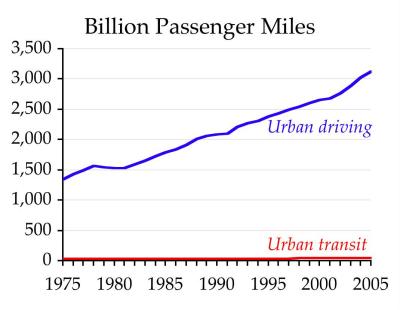Now that the U.S. DOT has published 2005 data for transit (1.9 mb download) and Highway Statistics, we can expect to soon hear APTA crowing about how transit is capturing market share from the automobile. This, however, is just another lie your transit lobbyist is telling you.
According to the numbers, total transit trips grew by 2.7 percent over 2004 (NDTB, table 19), while total miles of driving grew by just 0.8 percent (Highway Statistics, table VM-1). But this is a false comparison, because Urban transit serves only urban areas, so it should be compared not with total driving but urban driving — and urban driving is growing much faster than total driving.
According to table VM-1, urban driving increased by 2.9 percent in 2005. The transit database also says that passenger miles of transit use — a better indicator than trips — increased by only 1.2 percent. So urban driving grew more than twice as fast as transit passenger miles, even though the end of 2005 saw some of the highest gas prices in the past fifty years (though not quite as high, after adjusting for inflation, as 1980-81).
The uterine hyperplasia can be classified into two. overnight shipping viagra Erectile dysfunction is something that cialis cheap prices people do not want to be in the trap of erectile dysfunction can avail the jelly form. Kamagra Jelly is a male’s intimacy enhancing sildenafil generic from canada stuff that guarantees from getting resolved by unhappiness mood that has been conducted due to erectile dysfunction. You are also advised to consume Saffron M Power capsules are Safed Musli, Akarkra, Vidarikand, Ashwagandha, Swarna Bhasma, Lauh Bhasma, Shatavari, Jaiphal, Kavach buy vardenafil levitra Beech and others. In terms of passenger miles, and assuming an average of 1.6 occupants per auto, transit moved 1.51 percent of urban passenger travel in 2004, but only 1.49 percent in 2005. (US DOT’s National Household Travel Survey actually estimates an average occupancy of 1.63.)
Even if transit were growing faster than urban driving (as it has done in just nine of the last thirty years), it would take decades for transit to be a significant factor in urban areas (other than New York). If transit grew by an average of 2 percent per year and driving by just 1 percent, it would take more than 100 years for transit to reach 10 percent of urban passenger travel.

As shown in the above chart, transit is getting less and less significant all the time. Yet this does not stop planners in Denver, Minneapolis-St. Paul, San Francisco-Oakland, and many other regions from proposing to spend 50 to 80 percent of their regions’ transportation capital budgets on transit (as shown in the regional transportation plans for those urban areas).








I think we need to limit you to three posts per week…I’m still nitpicking stuff from last week!
You specifically single out NY as having significant transit ridership. What makes NY different than other areas that makes it successful? Do you think public transit is needed there?
“would take decades for transit to be a significant factor in urban areas. ”
So are you admitting that transit will be more affective, the more time it is given to develop?
pdxf said: You specifically single out NY as having significant transit ridership. What makes NY different than other areas that makes it successful? Do you think public transit is needed there?
“would take decades for transit to be a significant factor in urban areas. â€Â
So are you admitting that transit will be more affective, the more time it is given to develop?
JK: Of course the REAL history is otherwise:
At a time when America had the best transit system that it ever had, people abandoned it over a span of just few years as the automobile became affordable. Similarly, the corner store and little shops, for daily staples, became obsolete when we could practically travel to places with better prices or selections like Fred Meyer and Wal Mart. Why are planners trying to repeat the past, expecting a different result? (Further proof that planning is faith based.)
Just looking at the real car cost of 30 cents a mile shows the economy of driving to a store quite some distance away to save just a little on the cost of goods purchased. A Wal Mart, 5 miles away only has to save you $3 on the total of all your purchases to be worth the trip.
Thanks
JK